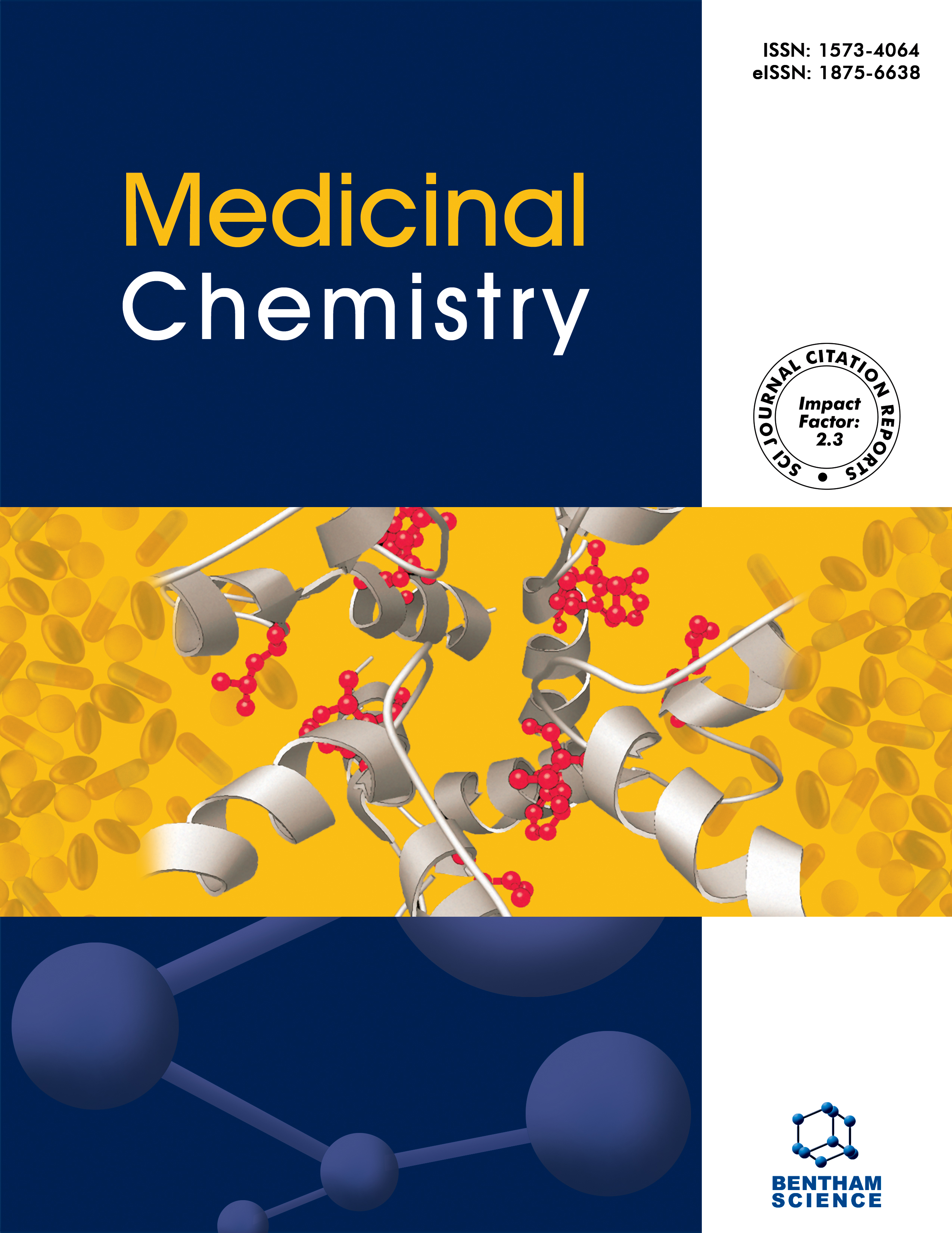- Home
- A-Z Publications
- Medicinal Chemistry
- Previous Issues
- Volume 15, Issue 5, 2019
Medicinal Chemistry - Volume 15, Issue 5, 2019
Volume 15, Issue 5, 2019
-
-
Structural Variability in the RLR-MAVS Pathway and Sensitive Detection of Viral RNAs
More LessCells need high-sensitivity detection of non-self molecules in order to fight against pathogens. These cellular sensors are thus of significant importance to medicinal purposes, especially for treating novel emerging pathogens. RIG-I-like receptors (RLRs) are intracellular sensors for viral RNAs (vRNAs). Their active forms activate mitochondrial antiviral signaling protein (MAVS) and trigger downstream immune responses a Read More
-
-
-
The Multiple Applications and Possible Mechanisms of the Hyperbaric Oxygenation Therapy
More LessAuthors: Wan Chen, Xingmei Liang, Zhihuan Nong, Yaoxuan Li, Xiaorong Pan, Chunxia Chen and Luying HuangHyperbaric Oxygenation Therapy (HBOT) is used as an adjunctive method for multiple diseases. The method meets the routine treating and is non-invasive, as well as provides 100% pure oxygen (O2), which is at above-normal atmospheric pressure in a specialized chamber. It is well known that in the condition of O2 deficiency, it will induce a series of adverse events. In order to prevent the injury induced by anoxia, the capability Read More
-
-
-
pLoc_bal-mEuk: Predict Subcellular Localization of Eukaryotic Proteins by General PseAAC and Quasi-balancing Training Dataset
More LessAuthors: Kuo-Chen Chou, Xiang Cheng and Xuan XiaoBackground/Objective: Information of protein subcellular localization is crucially important for both basic research and drug development. With the explosive growth of protein sequences discovered in the post-genomic age, it is highly demanded to develop powerful bioinformatics tools for timely and effectively identifying their subcellular localization purely based on the sequence information alone. Recently, a predictor call Read More
-
-
-
The Inhibition of Polysialyltranseferase ST8SiaIV Through Heparin Binding to Polysialyltransferase Domain (PSTD)
More LessAuthors: Li-Xin Peng, Xue-Hui Liu, Bo Lu, Si-Ming Liao, Feng Zhou, Ji-Min Huang, Dong Chen, Frederic A. Troy II, Guo-Ping Zhou and Ri-Bo HuangBackground: The polysialic acid (polySia) is a unique carbohydrate polymer produced on the surface Of Neuronal Cell Adhesion Molecule (NCAM) in a number of cancer cells, and strongly correlates with the migration and invasion of tumor cells and with aggressive, metastatic disease and poor clinical prognosis in the clinic. Its synthesis is catalyzed by two polysialyltransferases (polySTs), ST8SiaIV (PST) and ST8SiaII (STX). Selecti Read More
-
-
-
pLoc_bal-mVirus: Predict Subcellular Localization of Multi-Label Virus Proteins by Chou's General PseAAC and IHTS Treatment to Balance Training Dataset
More LessAuthors: Xuan Xiao, Xiang Cheng, Genqiang Chen, Qi Mao and Kuo-Chen ChouBackground/Objective: Knowledge of protein subcellular localization is vitally important for both basic research and drug development. Facing the avalanche of protein sequences emerging in the post-genomic age, it is urgent to develop computational tools for timely and effectively identifying their subcellular localization based on the sequence information alone. Recently, a predictor called “pLoc-mVirus” was developed for ide Read More
-
-
-
Inhibition of α-amylase Activity by Zn2+: Insights from Spectroscopy and Molecular Dynamics Simulations
More LessAuthors: Si-Ming Liao, Nai-Kun Shen, Ge Liang, Bo Lu, Zhi-Long Lu, Li-Xin Peng, Feng Zhou, Li-Qin Du, Yu-Tuo Wei, Guo-Ping Zhou and Ri-Bo HuangBackground: Inhibition of α-amylase activity is an important strategy in the treatment of diabetes mellitus. An important treatment for diabetes mellitus is to reduce the digestion of carbohydrates and blood glucose concentrations. Inhibiting the activity of carbohydrate-degrading enzymes such as α-amylase and glucosidase significantly decreases the blood glucose level. Most inhibitors of α-amylase have serious adverse eff Read More
-
-
-
Synthesis and Biological Evaluation of Polyfluoroalkylated Antipyrines and their Isomeric O-Methylpyrazoles
More LessBackground: Formally belonging to the non-steroidal anti-inflammatory drug class pyrazolones have long been used in medical practices. Objective: Our goal is to synthesize N-methylated 1-aryl-3-polyfluoroalkylpyrazolones as fluorinated analogs of antipyrine, their isomeric O-methylated derivatives resembling celecoxib structure and evaluate biological activities of obtained compounds. Methods: In vitro (permeability) and Read More
-
-
-
Synthesis and Biological Studies of New Multifunctional Curcumin Platforms for Anticancer Drug Delivery
More LessBackground: Scientists have extensively investigated curcumin, yielding many publications on treatments of cancer. Numerous derivatives of curcumin were synthesized, evaluated for their anti-oxidant and free-radical scavenging, SAR, ADME properties and tested in anticancer applications. Objective: We decided to exploit curcumin as a bioactive core platform for carrying anticancer drugs, which likely possesse Read More
-
-
-
Anticancer Activity and Topoisomerase II Inhibition of Naphthalimides with ω-Hydroxylalkylamine Side-Chains of Different Lengths
More LessBackground: The substituted 1,8-Naphthalimides (1H-benzo[de]isoquinoline-1,3(2H)- diones) are known as DNA intercalators stabilizing DNA-Topoisomerase II complexes. This interaction disrupts the cleavage-relegation equilibrium of Topo II, resulting in formation of broken strands of DNA. Objective: To investigate the influence of type of substituents and substitution positions in 1,8- naphthalimde skeleton on the inhibiti Read More
-
-
-
Design, Synthesis and In Vitro Evaluation of Novel Anti-HIV 3-Pyrazol-3-yl-Pyridin-2-One Analogs
More LessBackground: Natural products have shown potent anti-HIV activity, but some of these also possess toxicity. The pharmacophoric fragments of these natural products have scope of combination with other pharmacophoric fragment and derivatization to reduce toxicity and increase the potency. Combination of natural product fragments from different classes of anti–HIV compounds may lead to a new class of potent anti–HIV age Read More
-
Volumes & issues
-
Volume 21 (2025)
-
Volume 20 (2024)
-
Volume 19 (2023)
-
Volume 18 (2022)
-
Volume 17 (2021)
-
Volume 16 (2020)
-
Volume 15 (2019)
-
Volume 14 (2018)
-
Volume 13 (2017)
-
Volume 12 (2016)
-
Volume 11 (2015)
-
Volume 10 (2014)
-
Volume 9 (2013)
-
Volume 8 (2012)
-
Volume 7 (2011)
-
Volume 6 (2010)
-
Volume 5 (2009)
-
Volume 4 (2008)
-
Volume 3 (2007)
-
Volume 2 (2006)
-
Volume 1 (2005)
Most Read This Month
Article
content/journals/mc
Journal
10
5
false
en


